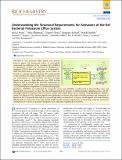Files in this item
Understanding the structural requirements for activators of the Kef bacterial potassium efflux system
Item metadata
| dc.contributor.author | Healy, Jessica | |
| dc.contributor.author | Ekkerman, Silvia | |
| dc.contributor.author | Pliotas, Christos | |
| dc.contributor.author | Richard, Morgiane | |
| dc.contributor.author | Bartlett, Wendy | |
| dc.contributor.author | Grayer, Samuel C. | |
| dc.contributor.author | Morris, Garrett M. | |
| dc.contributor.author | Miller, Samantha | |
| dc.contributor.author | Booth, Ian R. | |
| dc.contributor.author | Conway, Stuart J. | |
| dc.contributor.author | Rasmussen, Tim | |
| dc.date.accessioned | 2014-07-21T11:01:02Z | |
| dc.date.available | 2014-07-21T11:01:02Z | |
| dc.date.issued | 2014-03-06 | |
| dc.identifier | 122516046 | |
| dc.identifier | 23bb24ad-e62a-47b3-9a54-661a2ac6d30b | |
| dc.identifier | 84898059795 | |
| dc.identifier.citation | Healy , J , Ekkerman , S , Pliotas , C , Richard , M , Bartlett , W , Grayer , S C , Morris , G M , Miller , S , Booth , I R , Conway , S J & Rasmussen , T 2014 , ' Understanding the structural requirements for activators of the Kef bacterial potassium efflux system ' , Biochemistry , vol. 53 , no. 12 , pp. 1982-1992 . https://doi.org/10.1021/bi5001118 | en |
| dc.identifier.issn | 0006-2960 | |
| dc.identifier.other | ORCID: /0000-0002-4309-4858/work/31524147 | |
| dc.identifier.uri | https://hdl.handle.net/10023/5041 | |
| dc.description | This work was supported by The Wellcome Trust (WT092552MA), The Leverhulme Trust (EM-2012-60\2), BBSRC SysMO (BB/F003455/1), a European Union Marie Curie ITN Award (NICHE; 289384) | en |
| dc.description.abstract | The potassium efflux system, Kef, protects bacteria against the detrimental effects of electrophilic compounds via acidification of the cytoplasm. Kef is inhibited by glutathione (GSH) but activated by glutathione-S-conjugates (GS-X) formed in the presence of electrophiles. GSH and GS-X bind to overlapping sites on Kef, which are located in a cytosolic regulatory domain. The central paradox of this activation mechanism is that GSH is abundant in cells (at concentrations of 10–20 mM), and thus, activating ligands must possess a high differential over GSH in their affinity for Kef. To investigate the structural requirements for binding of a ligand to Kef, a novel fluorescent reporter ligand, S-{[5-(dimethylamino)naphthalen-1-yl]sulfonylaminopropyl} glutathione (DNGSH), was synthesized. By competition assays using DNGSH, complemented by direct binding assays and thermal shift measurements, we show that the well-characterized Kef activator, N-ethylsuccinimido-S-glutathione, has a 10–20-fold higher affinity for Kef than GSH. In contrast, another native ligand that is a poor activator, S-lactoylglutathione, exhibits a similar Kef affinity to GSH. Synthetic ligands were synthesized to contain either rigid or flexible structures and investigated as ligands for Kef. Compounds with rigid structures and high affinity activated Kef. In contrast, flexible ligands with similar binding affinities did not activate Kef. These data provide insight into the structural requirements for Kef gating, paving the way for the development of a screen for potential therapeutic lead compounds targeting the Kef system. | |
| dc.format.extent | 11 | |
| dc.format.extent | 4611380 | |
| dc.language.iso | eng | |
| dc.relation.ispartof | Biochemistry | en |
| dc.subject | QR Microbiology | en |
| dc.subject.lcc | QR | en |
| dc.title | Understanding the structural requirements for activators of the Kef bacterial potassium efflux system | en |
| dc.type | Journal article | en |
| dc.contributor.institution | University of St Andrews. School of Chemistry | en |
| dc.contributor.institution | University of St Andrews. Biomedical Sciences Research Complex | en |
| dc.identifier.doi | https://doi.org/10.1021/bi5001118 | |
| dc.description.status | Peer reviewed | en |
This item appears in the following Collection(s)
Items in the St Andrews Research Repository are protected by copyright, with all rights reserved, unless otherwise indicated.

